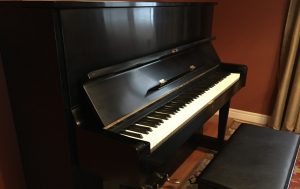 Not all pianos are created equal. From the outside, one piano can look pretty much like any other piano. Many buyers have bought a used piano only later on to find that it’s going to be very costly to repair, or even worse, cannot be tuned at all.
Not all pianos are created equal. From the outside, one piano can look pretty much like any other piano. Many buyers have bought a used piano only later on to find that it’s going to be very costly to repair, or even worse, cannot be tuned at all.
The following 5 steps highlight some of the more critical points you need to consider when you are getting ready to buy a used piano. This listing is by no means all encompassing – there have been hundred of articles and books written on the process of buying used pianos – this short list will give you a good starting point.
- Define your budget
The cost for a used piano can range anywhere from ‘free’ to over $50,000. It’s hard to get your head around that at first, but the majority of people are thinking of spending anywhere from $500 to $5,000 on a used piano. Although there can be some great buys out there, I typically recommend to people that they steer clear of pianos that are practically being given away – these will cost more in dollars and frustration than they are worth. The used piano market can be overwhelming at first. Spend some time gathering information about pianos that can be available that are in your price range. As a general rule, the more you pay for a used piano, the higher the resale value later on if you decide to try and resell it many years later. As with any musical instrument, it’s advised to spend as much money as you can on the instrument. You want a piano that will inspire you or your young musician to play, and be pleasant to listen to.
2. Determine a location for it in your home
First and foremost, you’ll need to determine how much piano you want to buy. A small apartment size piano will have it’s sound diminished in a large open style home. Conversely, a larger grand piano will be too overpowering in a small room. Once you’ve figured that out, you will need to focus on the placement of the piano in the room. As most people will treat a piano also as a piece of their furniture, you’ll have to struggle a little with a placement that is aesthetically pleasing, and one that adheres to these basic guidelines: Keep the piano away from heat sources (hot air registers and radiators) and drafts; Avoid placing the piano near large windows where it will be exposed to direct sunlight (or have light blocking blinds installed); Use available carpeting, furniture, and wall hangings to help dampen the reflected sound. As the humidity can have a major impact on the piano’s performance and tuning stability, aim to maintain a stable humidity around the 40-45% relative humidity level.
3. Don’t rush the selection process
Unless you have already found the piano that you’ve fallen in love with, make sure you devote enough time and energy in your search. It can be a daunting task – many people spend months or even years searching. If you have a defined budget, you’ll be able to narrow down the time spent. Try as many pianos as you can during your search. Talk to sales people at new and used piano stores. research types and makes of pianos online – there are some great resources out there that will help. It’s important to be happy with your purchase in the end. That happiness will fuel years of playing enjoyment.
4. Have the piano inspected
Private sale of used pianos online has been on the rise for a long time. There are risks that come with purchasing a piano this way, but there can also be some great deals through this method. When you find the piano that fits your needs and desires, it’s important to have it inspected by a certified piano technician. They have the knowledge and the expertise that’s needed for getting a thorough understanding of the piano’s condition. They will inspect the entire piano and provide you will a full status of it’s current health. Key to it’s health going forward is the ability for the piano to hold a tuning, and for all the key and notes to play correctly. if there are any issues, the piano technician will find them, assess the issue, and provide you with the course of action for resolving them, as well as their recommendations on the purchase. This service is a small price to pay for ensuring your purchase is a smart one.
5. Have the piano professional moved
Piano moving is an art. We’ve all seen famous pictures of a piano being lifted by a crane up to an apartment window. Fortunately, most piano moves are simply from a main floor in one house to another. Both upright and grand pianos are not just heavy but have certain characteristics about them that professional piano movers understand. There’s no reason for you to risk damaging your own body, your home, or damaging the piano by attempting to move it yourself. Hire a professional mover. Most local moves can be done for around $250-$300. Your certified piano technician should be able to point you to a reputable mover in your local area.
Following these 5 basic steps will help to ensure happiness with your purchase and years of playing enjoyment.
Larry Fine publishes an online piano buyers guide that will give you some other great things to consider when buying a piano. Here is a link to the online material – Piano Buyer